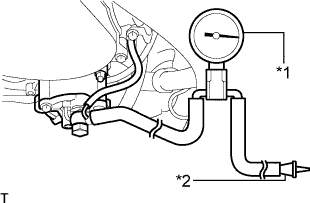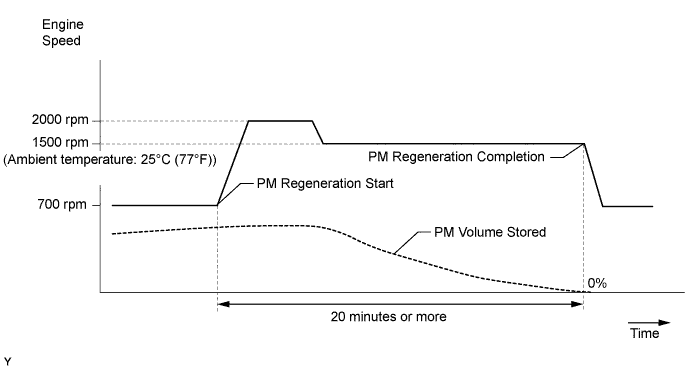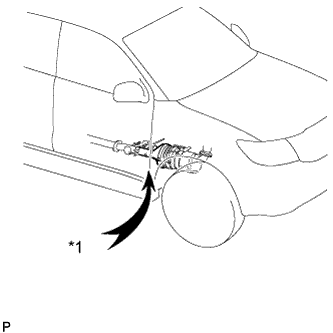Emission Control System (W/ Dpf) -- On-Vehicle Inspection |
| 1. CHECK SEATING OF EGR VALVE |
Check that the engine starts and idles.
Stop the engine.
| 2. CHECK EGR VALVE OPERATION |
Connect the intelligent tester to the DLC3.
Turn the ignition switch to ON and turn the tester on.
Enter the following menus: Powertrain / Engine and ECT / Active Test / Control the EGR Step Position.
Check the values of Target EGR Position and Actual EGR valve pos in the Data List.
- OK:
Control Range Condition Specified Condition Active Test performed (Set EGR position to 0% → 30% → 60% → 90% → 60% → 30% → 0%) Actual EGR valve opening percentage changes according to Active Test operation
| 3. VISUALLY INSPECT HOSES, CONNECTIONS AND GASKETS |
Visually check that the hoses, connections and gaskets have no cracks, leaks or damage.
- NOTICE:
- Detachment or other problems with the engine oil dipstick, filler cap, PCV hose or other components may cause the engine to run improperly.
- Air suction caused by disconnections, looseness or cracks in the parts of the air induction system between the throttle body and cylinder head will cause engine failure or engine malfunctions.
Check if the differential pressure sensor hoses are connected incorrectly, disconnected, leaking, cracked or otherwise damaged.
 |
| 4. CHECK VACUUM PUMP ASSEMBLY |
Disconnect the vacuum hose from the vacuum pump.
Connect the hose of a vacuum gauge to the pump.
Text in Illustration *1 Vacuum Gauge *2 Plug
 |
Insert a plug into the other hose of the gauge.
Start the engine and warm it up for more than 2 minutes.
With the engine idling, check the negative pressure of the pump.
- Standard negative pressure:
- More than 86.7 kPa (650 mmHg, 26 in.Hg)
- HINT:
- The vacuum pump assembly is listed as one of the 200000 km (124000 mile) maintenance parts. Make sure to disassemble and inspect it every 200000 km (124000 miles) and replace parts as necessary.
Remove the gauge from the pump.
Connect the hose to the pump with the clip.
| 5. PERFORM DPF FORCIBLE REGENERATION PROCEDURE |
Disconnect the cable from the negative (-) battery terminal or remove the EFI fuse for 1 minute or more.
- HINT:
- If the MIL is illuminated, first clear the DTCs using the intelligent tester, and then initialize the value for the amount of particulate matter recorded by the ECM by disconnecting the cable from the negative (-) battery terminal or removing the EFI fuse. Otherwise, forced DPF regeneration cannot be performed using the Active Test.
- If the MIL is not illuminated, proceed to the next step, as initialization is not necessary.
Connect the intelligent tester to the DLC3.
Start the engine and idle it until the engine coolant temperature reaches 70°C (158°F) or higher.
Move the shift lever to N and set the parking brake.
Turn the tester on.
Enter the following menus: Powertrain / Engine and ECT / Active Test / Activate the DPF Rejuvenate (PM).

- CAUTION:
- Before performing the Active Test, make sure that there are no combustible materials around the DPF and tailpipe.
- NOTICE:

- If the ambient temperature is 30°C (86°F) or higher, the DPF and surrounding area become very hot. Use a fan, etc. to cool the exhaust gas temperature sensors, air-fuel ratio sensor and surrounding areas.
Text in Illustration *1 Air - HINT:
- During the Active Test, the engine speed increases to 2000 rpm, and then decreases to a speed between 1500 and 2000 rpm which is determined by the intake air temperature. The Active Test then continues with the engine running at that speed.
- The engine speed increases during the Active Test and the engine speed returns to idle when the Active Test is completed.
- The time it takes to complete the Active Test varies depending on the PM volume stored. However, it usually takes approximately 20 minutes to complete the Active Test.
- Do not cancel the Active Test unless absolutely necessary.
- If the Active Test needs to be canceled, depress the accelerator pedal and race the engine or depress the clutch pedal to cancel the process. Even if the Active Test is stopped before it finishes, "Compl(complete) for DPNR/DPF Status Reju(PM)" is displayed on the intelligent tester. If the Active Test is canceled, it must be performed again.
- If the differential pressure value increases too much during the Active Test, the fail-safe function activates and the Active Test is stopped.
- It may not be possible to perform the Active Test when the ambient temperature is extremely low or the elevation is extremely high. In this case, perform the Active Test indoors (with the tailpipe pointed towards the outside) or drive the vehicle at a speed of approximately 60 km/h (37 mph) or more for approximately 20 minutes to perform regeneration.
- Depending on various conditions, the Active Test may not be completed within 20 minutes. If 60 minutes elapse, the system stops the Active Test and illuminates the MIL. If this happens, disconnect the cable from the negative (-) battery terminal or remove the EFI fuse for 1 minute or more so that the MIL turns off, and then perform the Active Test again.